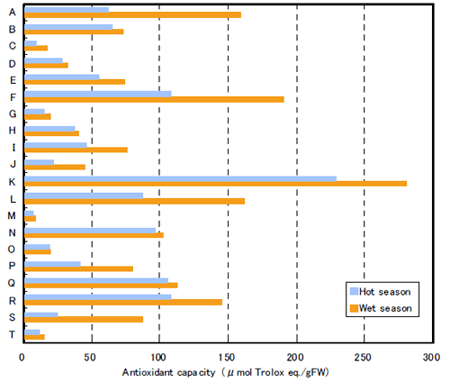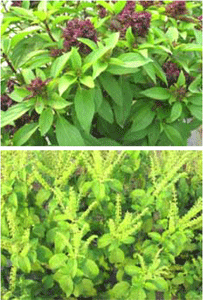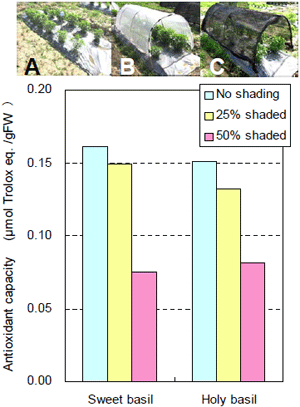Enhancing the antioxidant capacity of local vegetables by cultivation technique
Description
Vegetables contain antioxidative vitamins and polyphenols that are essential for human health. And, the antioxidant capacity of vegetables is now being recognized as an important factor in quality evaluation. In the previous studies, we found that many of the local vegetables of Thailand exhibit high antioxidant capacity. However, at the same time, we noticed that there is a seasonal rise and fall in their antioxidant capacity. In the current study, we cultivated 20 kinds of local vegetables in Thailand in three different seasons, namely dry (November to February), hot (February to May) and wet season (May to October) under irrigated condition. The DPPH (1,1-diphenyl-2-picrylhydrazyl) free radical scavenging capacity values as indication of the antioxidant capacity of the methanolic extracts of fresh vegetables were compared. In most of the vegetables studied, crops cultivated in the dry season had a higher antioxidant capacity than crops cultivated in the hot season (Fig. 1). In the central area of Thailand, solar irradiation in dry season is much higher than the other season, while the average temperatures in dry and hot seasons are not so different. Therefore, it was speculated that there would be a positive correlation between antioxidant capacity and solar irradiation. To validate this hypothesis, cultivation experiments with shading were performed using sweet basil (Ocimum basilicum) and holy basil (Ocimum sanctum) that are frequently consumed in Southeast Asia (Fig. 2). Antioxidant capacities of both basils dramatically decreased in shaded conditions (Fig. 3). We plan to provide this cultivation technique which enhances the antioxidant capacity of basils and other local vegetables to farmers in Southeast Asia.
Figure, table
-
Fig. 1. Seasonal changes in antioxidant capacity of local Thai vegetables.
Vegetables were cultivated in the experimental field of Kasetsart University (Nakhon Pathom, Thailand). Methanolic extracts of edible parts were used for the antioxidant assay (DPPH method). Each datum has an average of 15 measurements. Scientific names of vegetables are: Ocimum sanctum (A), Ipomoea batatas (B), Clinacanthus nutans (C), Coleus amboinicus (D), Garcinia cowa (E), Eleutherococcus trifoliatus (F), Averrhoa carambola (G), Plumbago zeylanica (H), Oenanthe stolonifera (I), Polyscias fruticosa (J), Cassia siamea (K), Houttuynia cordata (L), Averrhoa bilimbi (M), Momordica cochinchinensis (N), Pandanus odorus (O), Piper sarmentosum (P), Tiliacora triandra (Q), Passiflora edulis (R), Ocimum basilicum (S), and Morinda citrifolia (T). -
Fig. 2. Sweet basil (above, Ocimum basilicum) and holy basil (below, Ocimum sanctum). -
Fig. 3. Shading experiment.
Upper panel: Cultivation without shade (A), 25% shaded (B) and 50% shaded (C).
Lower panel: Antioxidant capacity of basils cultivated with each treatment.
- Affiliation
-
Japan International Research Center for Agricultural Sciences Post-harvest Science and Technology Division
- Classification
-
Technical A
- Term of research
-
FY2006~2008(FY2006~2011)
- Responsible researcher
-
NAKAHARA Kazuhiko ( Post-harvest Science and Technology Division )
TIRATANAKUL Vorapong ( Asian Vegetable Research and Development Center )
SUZUKI Masaaki ( Asian Vegetable Research and Development Center )
OOI Peter AunーChuan ( Asian Vegetable Research and Development Center )
- ほか
- Publication, etc.
-
Tiratanakul, V., Suzuki, M. and Nakahara, K. (2006) A study of the effect of shading on antioxidant activities of basils (sacred basil and sweet basil). International conference on indigenous vegetables and legumes (Hyderabad, India)
- Japanese PDF
-
2008_seikajouhou_A4_ja_Part20.pdf611.15 KB



